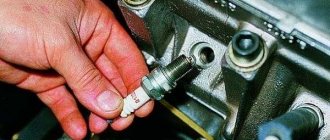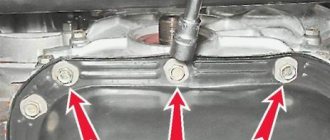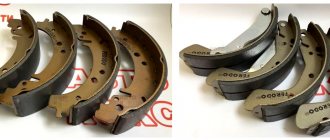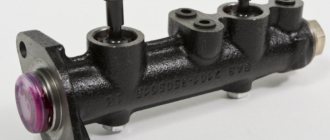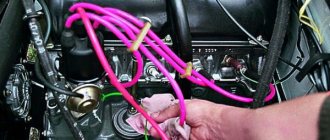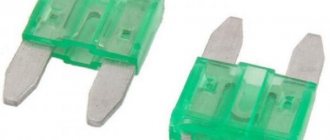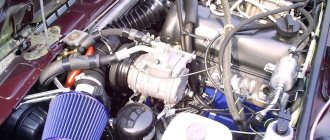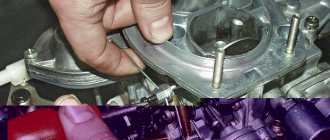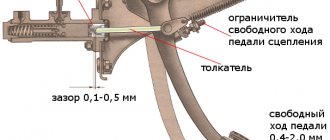NGK spark plugs for “classics” (VAZ 2101, 2102, 2103, 2104, 2105, 2106, 2107)
We will select NGK spark plugs (Japan-France) for carburetor and injection engines of “classic” VAZ cars (2101, 2102, 2103, 2104, 2105, 2106, 2107) with contact and non-contact ignition systems.
The list below is far from complete, but includes the most common and most frequently used NGK spark plugs on “classics”. General requirements for spark plugs for carburetor and injection engines VAZ 2101-2107
— Heat number — 17
— Length of the threaded part — 19 mm
— The heat cone protrudes beyond the spark plug insulator
— The gap between the electrodes is 0.7-0.8 mm (contact and non-contact ignition systems, carburetor engine), 0.9-1.1 mm (injection engine)
— Availability of an interference suppression resistor for spark plugs for engines with contactless ignition systems and injection engines
— Hexagon (nut) — 21 mm
Selection of NGK spark plugs for “classics”
Contact ignition system
BP6ES code 7811 (standard)
BP6ES V-LINE No. 4 code 5637 (with a v-shaped cutout on the central electrode)
BPR6EIX code 6637 (with resistor and iridium center electrode)
BUR6ET V-LINE No. 1 code 2876 (with resistor, three-electrode, with a v-shaped cutout on the central electrode)
Contactless ignition system
BPR6ES code 7822 (standard with resistor)
BPR6ES V-LINE No. 2 code 2268 (with resistor and v-shaped cutout on the central electrode)
BPR6EIX code 6637 (with resistor and iridium center electrode)
BUR6ET V-LINE No. 1 code 2876 (with resistor, three-electrode, with a v-shaped cutout on the central electrode)
BPR6ES-11 code 4824 (standard with resistor)
BPR6ES-11 V-LINE No. 13 code 5339 (with resistor and v-shaped cutout on the central electrode)
BPR6EIX-11 code 3903 (with resistor and iridium central electrode)
BUR6ET V-LINE No. 1 code 2876 (with resistor, three-electrode, with a v-shaped cutout on the central electrode)
Notes and additions
— Spark plugs for a contact ignition system, with some exceptions, are not recommended for installation on engines with a contactless system or fuel injection, but vice versa is possible.
— The “classic” injection engines discussed in the article are 2104 and 21067.
High voltage wires
Sometimes they are the problem. They can also fail. Checking their condition is very simple - to do this, just start the engine in the dark and open the hood. Sparks should not run near high-voltage wires.
If so, it means it has become unusable. Typically, armored wires “run” for a very long time - about one hundred thousand kilometers. But no one ruled out the risk of defects or fakes. By the way, it is not recommended to do the test during daylight hours - it is very difficult to notice sparks. They are small in size and appear briefly from different places. Below you will find detailed instructions on “How to check the spark plugs yourself.”
Cost and article number of original spark plugs for VAZ 2107 and their analogues
On the VAZ 2107 car, which has a carburetor and a contact ignition system, original A17DVR spark plugs with catalog number 21010-3707010-86 are used. They cost from 240 to 350 rubles. Consumables from the Engels plant are packaged under the LADA brand.
In retail sales, a direct analogue is found with article number A17DVR. Other good alternatives to native candles can be found in the table below.
Table - The best analogs of original spark plugs for a VAZ 2107 with a carburetor and a contact ignition system
On carburetor VAZ 2107 with contactless ignition, original spark plugs A17DV-10 with article numbers 2108-3707010-86 and 21080-3707010-86 are used. The price for these consumables ranges from 230 to 350 rubles. LADA only completes spark plugs to sell under its own brand.
The real manufacturer is the Engels plant. It produces a direct analogue with catalog number A17DV-10. Other good alternatives can be found in the table below.
Table - Optimal alternatives to branded spark plugs for a carburetor VAZ 2107 with a contactless ignition system
The VAZ 2107, which has an injector under the hood, uses original A17DVRM spark plugs with article numbers:
The cost of branded consumables varies from 210 to 300 rubles. Despite the fact that candles are sold under the LADA brand, they are produced by the Engels plant. It produces identical consumables for retail sale under the article number A17DVRM. Other good third-party products can be found in the table below.
Table - The best alternatives to original spark plugs for the injection VAZ 2107
A distinctive feature of spark plugs for the carburetor VAZ 2107 with a contact ignition system is the absence of an interference suppression resistor. The spark plugs and the gap differ. It is largest for an injection car and is 1.0-1.1 mm.
The smallest gap is for cars with a contact ignition system. On them it is only 0.5-0.6 mm. The VAZ 2107 with contactless ignition has an average distance between the electrodes. For such machines, the gap is in the range of 0.7-0.8 mm.
NGK 7529 BP6E
NGK 7529 BP6E
The spark plugs are universal and work across the entire range of temperatures and loads. They are resistant to the formation of deposits on the insulator, maintain the shape of the electrodes and the size of the gap. V-line technology ensures uninterrupted sparking. The copper rod in the central electrode removes heat, preventing overheating and damage to the insulator. The sealing of the housing is adequately done, the tightness is always at its best.
The gap for these spark plugs is 0.9 mm. This means that it is better not to use the product for a carburetor engine, only an injector.
The price for such quality is attractive and does not go out of the general range in the category.
The cost of candles is, on average, 150 rubles per piece.
Advantages and disadvantages
Good engine starting in any weather. Sparking without interruption due to the use of new technology. Excellent tightness. Compliance price/quality.
There are often fakes on the market
Recommendations for replacement intervals
According to official recommendations, replacement of spark plugs is required every 30 thousand km. In real conditions, low fuel quality causes consumables to fail by 12-15 thousand km. The need for replacement can be determined by the following symptoms:
- there is a missing spark;
- During the inspection, black spark plugs with irremovable carbon deposits were found;
- Any damage shown in the image below has been identified.
How to choose the right spark plugs
A mistake in choosing spark plugs can “kill” the engine. Spark plugs can affect fuel consumption. There are “incompatible” spark plugs and high-voltage wires. In this article, we'll look at what you really need to know and consider if you service your car yourself. After all, this small device, which looks so simple, is in fact a complex and high-tech product with strictly adjusted dimensions, made from materials specially designed for candles.
Spark plug device
Device
The candle is assembled in a metal case, which has a threaded part (thread diameter from 8 to 18 mm) and a hexagon (from 13 to 25.4 mm). A ceramic insulator is installed in the housing, with an electrode running through the center. The lower part of the insulator forms a thermal cone, which is placed on a heat sink for better heat removal. Depending on the design, a resistor or glass sealant is placed between the central electrode and the contact rod. The assembled insulator is rolled into the housing. In the lower part, one or more side electrodes are welded to the end of the housing.
“Hot” and “cold” or what is the heat rating
The part of the spark plug that is inside the combustion chamber must have a strictly defined temperature when the engine is running at full power - from 500 to 600 degrees Celsius. Engines with different degrees of boost have different thermal load, based on which the size of the thermal cone and the contact area between it and the housing are selected.
If the temperature is lower, the candle will not “self-clean” and will become covered with soot. After some time, the electrodes will close and the spark plug will stop working. This happens when the installed spark plugs are too “cold” - they have too high a heat rating: for example, if instead of A17 you install A23, the engine “doesn’t like” such spark plugs, it will begin to have difficulty starting, often “triple”, and shake at idle. The engine loses power and gasoline consumption increases. This is, of course, bad.
It is much worse when spark plugs that are too “hot” are installed in the engine, that is, those with a lower heat rating. Due to the high temperature of the electrodes and the thermal cone of the insulator, the combustible mixture, entering the cylinder, is ignited not by a spark, but by the hot parts of the spark plug. This happens “spontaneously” - sometimes earlier, sometimes later, the engine suddenly loses power, runs after the ignition is turned off, and the valves and piston may “burn out.”
Highly accelerated, high-speed engines are usually equipped with “cold” spark plugs. They feel great under heavy loads, but long periods of idling or light loads will lead to the formation of a layer of carbon deposits.
Engines with an average degree of boost, for example VAZ engines, require spark plugs with an average heat value.
Low-speed, non-boosted engines are equipped with spark plugs with low heat ratings - “hot”.
What you need to know about the marking of spark plugs and which ones to put on the VAZ-2107
According to domestic GOSTs, this is A17DVRM , where 17 is the heat number (candles are produced from 10 to 23 units). The remaining letters indicate design and dimensional features. Today we need the letter “P” to indicate that a noise suppression resistor is built into the spark plug.
Here is an example of NGK markings: BPR6ES11 . Here the number 6 is the heat number (on a scale from 2 to 13 units), the letter R indicates the presence of a resistor. Expensive brands of candles have the letter “Z” instead of “R” - this is an inductive resistor, it does not lead to loss of spark energy. The number “11” at the end of the mark indicates a gap of 1.1 mm. These spark plugs are suitable for injection "seven".
For carburetor models, choose spark plugs without the letter “P” or “R” in the marking: A17DVM, BP6E . They do not have a built-in noise suppression resistor, which will weaken the already not very powerful spark.
Expensive spark plugs with platinum and iridium electrodes have good performance and last a very long time. But it is very difficult to find a model for carburetor engines among them - they all come with a built-in resistance. The solution is to choose a model with an inductive resistor (Z in the marking).
Below you can see recommendations for candles from other manufacturers.
For classic VAZ models with contact ignition
- BERU W7D
- BOSCH W7D
- BRISK L15Y
- CHAMPION N10Y
- DENSO W20EP
- EYQUEM 707LS
- MARELLI FL7LP
- FINVAL F501
- HOLA S12
- WEEN 121-1371. The gap between the electrodes should be 0.5-0.7 millimeters.
For models with contactless protection
- BERU 14-7D, 14-7DU, 14R-7DU
- BOSCH W7D, WR7DC, WR7DP
- BRISK L15Y, L15YC, LR15Y
- CHAMPION N10Y, N9Y, N9YC, RN9Y
- DENSO W20EP, W20EPU, W20EXR
- EYQUEM 707LS, C52LS
- MARELLI FL7LP, F7LC, FL7LPR
- FINVAL F508
- HOLA S13
- WEEN 121-1378. And the gap here is needed a little more - 0.7-0.8 millimeters.
For injection engines
- BERU 14R7DU
- BOSCH WR7DC
- CHAMPION RN9YC
- DENSO W20EPR
- EYQUEM RC52LS
- MARELLI F7LPR
- FINVAL F510
- HOLA S14
- WEEN 121-1370. The gap size here is larger - 0.9-1.0 millimeters.
This list, of course, is not complete; there are a lot of manufacturing companies.
How to choose high-voltage wires
An error in the choice of wires can lead to poor engine starting, increased fuel consumption, unstable operation and “dullness” during acceleration. The thing is that the wires are now made of silicone, with a graphite central core and increased distributed resistance. This is done to reduce the level of electromagnetic interference that can interfere with the operation of numerous on-board electronics. Injector ignition systems have very high spark energy and these wires are ideal for them. But for carburetor cars, wires need to be selected with the least resistance. The best you can find is from 2 to 4 kilo-ohms per wire; “zero” wires with a copper core cannot be found on sale at all. How to choose? Take a multimeter with you and ask the seller for permission to “measure” several sets from different manufacturers. And sometimes the resistance value of the wires is marked on the packaging. In the distributor of carburetor cars, or rather in its “runner”, another noise suppression resistor is installed. This “relic of the past” needs to be replaced with a suitable piece of wire, because the function of this element is now performed by high-voltage wires.
Self-identification of problems
The procedure is not difficult. The easiest way is visual. The most difficult one involves a detailed study of the engine’s performance.
One of the obvious signs of these breakdowns is a malfunction in the engine. For example, it may be difficult to start, or it may have an idle speed.
Other signs are:
- The first is related to the rotation of the crankshaft. If it rotates at the required frequency, but the engine itself does not start, this is a sign of lack of ignition. In other words, the air mixture does not ignite.
- If a mixture of fuel and air flares up in the cylinders, the engine may operate extremely unstable.
- When starting the engine, the starter does not function. As a result, the engine also fades out.
- Very high fuel costs. If the composition of fuel and air does not ignite, then the power of the power unit is reduced or drops to zero. Power losses can be compensated by supplying an increased dose of fuel to the cylinders. And the result is an impressive waste of fuel.
- The catalyst is not working. If there is no ignition in the technology, there is no combustion of the air-fuel composition. And the fuel that does not ignite ends up in the catalyst. And there it oxidizes. And the catalyst stops functioning.
- A cold engine does not start well. When turning the ignition, cold ones accumulate condensation. And it is considered an excellent conductor of electricity. If the distance between the electrodes increases, then the degree of breakdown voltage should develop. It cannot be developed independently, because the energy will be eliminated through the indicated electrodes, as well as through a ceramic cone.
- There are traces of mechanical defects on the surface. This is a sign of either complete breakdown or malfunction.
- There are carbon deposits and deposits on the electrodes. The candles themselves smell like fuel. This is evidence that the system itself, and every single one of them, is faulty.
- A damaged cable carrying high voltage can seriously impair normal operation.
TOP 10 best spark plugs for VAZ (Lada)
The most common type is gasoline cars, which require full maintenance. Usually a simple part like spark plugs doesn't raise many questions. However, the unit requires more attention than most motorists think. The stability of the engine and the service life of the ignition system depend on the correct choice.
In 2022, there are a large number of models and companies on the market that, in their opinion, produce the best spark plugs for VAZ and other car models. But it is not always the case.
HOLA S12
HOLA S12
S12 spark plugs provide good performance. The technologies used operate under worse conditions than the intended purpose of budget devices. A distinctive feature is uninterrupted operation when installing gas equipment on a car.
The product has a small gap, which is why it can work well on old AvtoVAZ engines, including at low temperatures.
Reliability is acceptable, but does not allow this product to be ranked among the best in the rating. Other average indicators correspond to the price, you can buy with confidence.
The average cost per unit is 110 rubles.
Advantages and disadvantages
Possibility of installation on cars with LPG. Reasonable price. Starting the engine at low air temperatures. Application of innovative technologies in manufacturing.
Low reliability due to manufacturing defects
Which spark plugs for VAZ are better to choose?
There are a large number of different modifications of the part, which complicates life for motorists. The problem is that each motor is designed for a specific type of spark plug. If you supply the wrong part, a number of negative consequences can arise.
- Misfire of the mixture due to the gap between the electrodes of the element being too wide.
- Interruptions in the operation of the internal combustion engine caused by too low spark power.
- Instant failure of the device due to too much electrode protrusion.
Also, depending on the inconsistencies present, other malfunctions may “pop up” that reduce the comfort of using the car.
What to look for when choosing.
Specialists from the AvtoVAZ plant recommend selecting spark plugs according to a number of parameters.
- Heat number. The parameter characterizes the rate of heat removal from the working part of the candle. At the same time, the electrode transfers excess heat to the spark plug skirt in a timely manner, which ensures stable operation of the part. If energy is removed too quickly, scale forms on the working part of the part, which prevents normal spark breakdown. If the withdrawal is too slow, the thin electrode overheats. The process provokes the formation of glow ignition. This prevents the engine from operating normally due to detonation of the mixture or its early ignition. Under normal thermal conditions, a spark adequately breaks through the spark plugs and does not form excessive carbon deposits.
- Spark gap. Some users know that for the engine to operate correctly, the spark gap on the spark plugs must be maintained. The working gap on VAZ spark plugs is strictly set by the manufacturer of the power plant and is necessary due to the fact that the formed electric arc has a certain strength. As the distance increases, the spark loses stability, which can lead to misfires. In the opposite case, easier starting of the engine is ensured, but when the gas is released, the electric arc current may not be enough. This is justified by the fact that each ignition coil has a certain transformation ratio, usually equal to 2000 units. This means that during the start-up of the internal combustion engine, the elements produce up to 14 kW, and during normal operation it is already 24. Consequently, failure to comply with this parameter can lead to serious disruptions in the operation of the motor.
- Departure of the working part of the electrodes. The parameter is critical for adequate operation of the power plant. The spark plugs on the VAZ 8-valve injector, as well as for carburetor models, have electrodes strongly pushed forward. This is due to the fact that the structural parts are located in the corner of the combustion chamber, where there is no adequate ventilation. The overhang of the working part allows for better ignition of the mixture and stabilizes engine operation. If the spark plugs are mounted in a multi-valve engine, where the inserts are located in the center of the valve head, it is recommended to install spark plugs with a deep-set core - this will prevent damage to the electrodes by the piston bottom and an abundance of carbon deposits on the structural elements.
- Number of electrodes. Initially, manufacturers position this parameter as a definite plus. When one electrode “burns out,” the spark plug switches to another, which significantly increases its service life. However, not everything is as simple as it seems at first glance. If the mixture is sprayed unevenly in the cylinder (poor ventilation of the combustion chamber), and at this moment the spark jumps to the shadowed part (the place where the exhaust remains), misfire may occur, which will lead to unstable operation of the power plant. Additionally, this fact increases the wear of the catalyst and engine oil, which is critical for VAZ cars.
- Manufacturer. The manufacturer of the product is also an important parameter. Users recommend buying from trusted brands that have been on the market for a long time. The cost of such candles will be significant, but with proper selection and operation they will work for a long time and without significant complaints.
By adhering to the specified parameters, a car enthusiast can buy a fairly high-quality product, while saving on the frequency of car servicing and repairs.
Every 30,000 km
As you noticed, the title does not indicate a temporary alternative to mileage, since many actions, in principle, do not have such an alternative. Therefore, this parameter will be indicated in each item separately. So, let's look at all the necessary procedures:
- Replacing the fuel filter. A clogged fuel filter for a car can cause a number of consequences. The first “bell” for replacement will be a decrease in the car’s power, after which the injectors may become unusable or the fuel lines may become clogged. It is best not to wait for such events by replacing the filter in a timely manner. The filter is changed every 1.5-2 years if you have not driven the required 30,000 km during this period.
- Replacing spark plugs. If you do not change the spark plugs in a timely manner, you will experience uneven engine operation, decreased power, and difficult starting. In addition, a non-burning fuel-air mixture can cause coking of the cylinders and valves. In a good way, spark plugs should be replaced before each winter. The same applies to glow plugs in diesel engines.
- Cleaning injectors. Dirty injectors can lead to approximately the same effect as worn-out spark plugs: unstable speed, decreased power, “clogging,” poor cold starts, etc.
- Cleaning the throttle valve is no less important than the last two. You can clean the throttle valve yourself, unlike cleaning the injectors.
- Battery diagnostics. In order to never stand with wires near an open hood, waiting for a kind car enthusiast ready to “light a cigarette,” check the battery more often. This procedure is especially important before winter.
If the above actions are not followed, sooner or later the car will refuse to move and you will have to eliminate the cause of the malfunction in any case. Therefore, for your own comfort, take care of the necessary actions in a timely manner at the 30,000 mileage.
LADA spark plugs: top 10 options
The rating contains 10 modifications of spark plugs, without division into specific car models.
10th place: ZZ A17 DVRM
The list of the best offers opens with an effective model that is in demand among a large number of buyers. Such prevalence is ensured by the stable quality of products. In the original packaging it is impossible to find a defective part or a spark plug with a broken gap. A significant advantage of the products is the ability to work actively even when the voltage drops to 6V in the on-board network. Similar spark plugs in the VAZ 2107 are often found due to their moderate cost.
